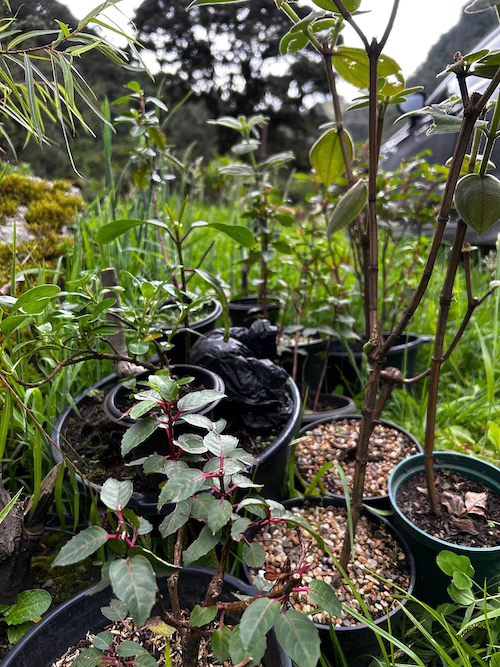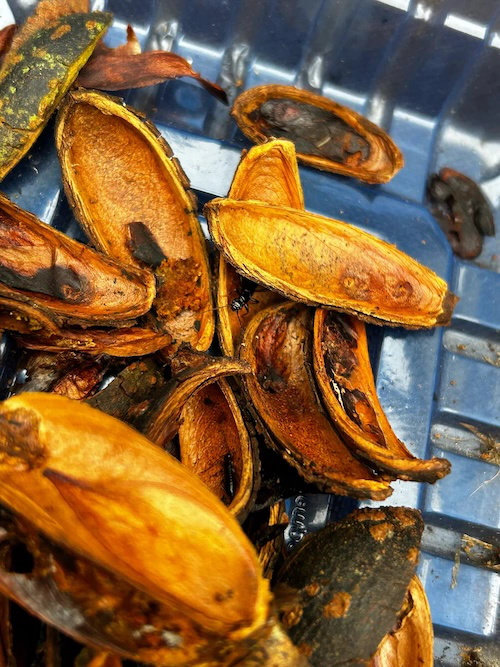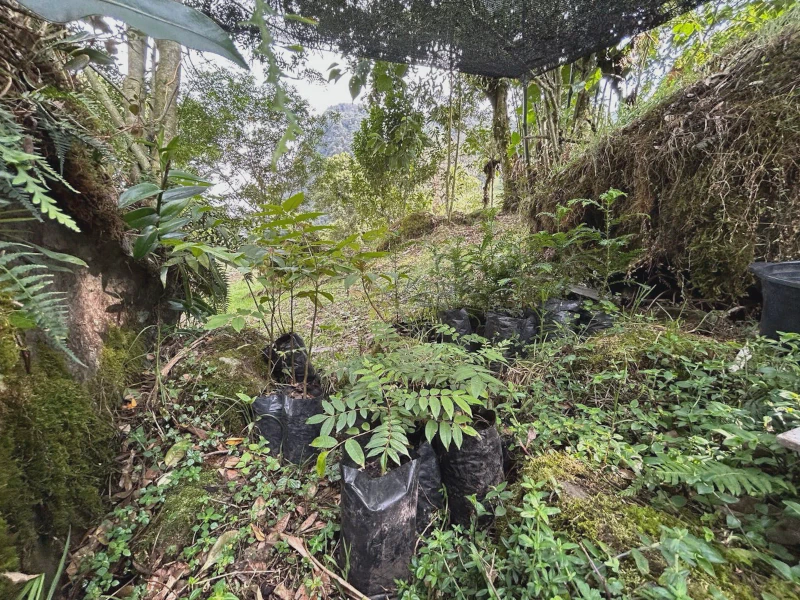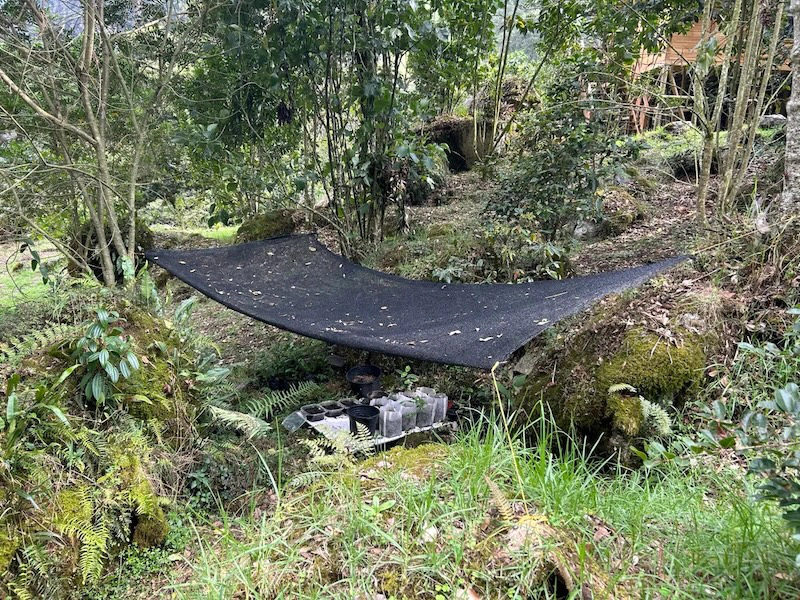We have a nursery!
(Disclaimer ⚠️🤖: This post translation from the original text in Spanish was assisted using Llama 3 running locally with Ollama)
About three years ago, when we bought the land where our reserve is now located, our first reaction was to go out and buy native tree saplings to speed up the restoration process. We brought in oaks, pines, wax palms, willows, and “sietecueros”. Over time, friends and neighbors gifted us seedlings and cuttings from their gardens to add more color to the forest. We also received donations of cedars, walnut trees, more Colombian pines, boxwoods, and palmitos from Mauricio Toquica (a germination wizard who collects seeds in Bogotá and germinates them in his garden in Madrid, Cundinamarca) and the Environmental Office of Choachí. Most of the tree saplings we’ve planted have survived, and together with the passive restoration process we told you about in another post, the pastureland we bought three years ago now looks more like a budding forest than a meadow.

All these efforts are necessary, and the good thing about not closing oneself to a single strategy is that, at the end of the day, the one benefiting is the restoration process. We’ve probably made several mistakes along the way, but that’s part of the necessary experimentation for learning and doing things a little better each day.
There is, however, a strategy that we didn’t intuitively think of: having a nursery for native-local plants. The same idea intimidated us. Setting up a nursery requires effort, money, and knowledge. You have to learn about substrates, fertilizers, irrigation techniques, germination processes, and you have to be vigilant all the time for the seedlings, or at least that’s what we thought. In reality, the idea of the nursery was already suggested by some people with expertise in restoration, and there are several reasons why:
- Restoring with seeds or seedlings from the area ensures that they are much better adapted than individuals of the same species but from another location.
- The costs of transportation and buying seedlings or saplings can be quite high. In fact, to bring a significant amount of saplings, you need to pay for transportation services that can represent up to one-third of the total cost of the purchase.
- Local species can be difficult to find in commercial nurseries. Additionally, these nurseries tend to favor species with commercial appeal rather than necessarily those with ecological value.
- The satisfaction of accompanying a tree from its early life stage makes the restoration work something much more powerful. You don’t come to heal the earth; you’ve come to accompany the earth in its natural process of regeneration.
We stumbled upon the nursery partly by accident and partly motivated by seeing the results of people like Mauricio with his cedars, walnut trees, and pines. Last year, we did some germination experiments with cedar and “alcaparro” seeds with mixed results: cedars are difficult both in obtaining viable seeds and successful germination, while “alcaparros” are more generous both in seed production and germination. The experiment wasn’t sophisticated. We collected the seeds from “mother” trees, selected those that looked viable at a glance, and planted them in plastic containers (recycled) with soil from the reserve without any special process. For the seeds that germinated, we transplanted the seedlings into bags and are waiting for the rainy season to plant them.

What to do? Germinate or “harvest”?
After this germination experiment, we set out to collect more seeds. We brought in fuchsia, cedrillo, and “espino garbanzo” from the forest, but nothing germinated. Given these circumstances, we opted for other less orthodox alternatives: we paid attention to what was already germinating naturally. If nature had already gotten a head start on the germination process, why not focus on “harvesting” seedlings to transplant later after a period of care and hardening?
This experiment worked much better:
- We found a spot under a large Clusia (Clusia sp.) where several seedlings had germinated, and we extracted them with care and transplanted them to other areas of the reserve. A year later, we have Clusia trees growing in parts of the reserve where the seeds from this mother tree wouldn’t have arrived until many generations later.
- When the “arrayanes” are loaded with fruit, many fall to the ground when it rains, and after a few weeks, you can see the seeds germinating on the soil. We took some of these and transplanted them into bags with soil; 100% survived, and some are already ready to transplant.

Suddenly, the amount of saplings waiting to be transplanted grew considerably. Between experiments and donations, we accumulated more or less 40 plants that, due to their size or because the climate wasn’t yet favorable, were waiting to be planted in their final location. Initially, we placed them under an “alcaparro” tree that gave them shade and protection from the elements.
“Building” the nursery.
The “alcaparro” tree worked well for a while, but we wanted to expand our capacity to germinate more seedlings and also needed a more comfortable space to work. Additionally, the leaf litter and seeds from the “alcaparro” tree contaminated the seedlings more than once, making the work more cumbersome.
We thought about simple solutions for the nursery, such as building a rustic wooden structure and covering it with polypore. However, seeing how well the “alcaparro” had worked, we went for an intermediate solution using elements we already had at hand in the reserve, following Mateo Hernández’s recommendations.

The terrain where the reserve is located is surrounded by large boulders and, in some parts, you can find natural niches formed by two or more rocks that offer natural protection from the wind, water, and sun. For our nursery, we chose one of these niches, which was also surrounded by some cordoncillos and “alcaparro” trees. With this, the nursery was almost ready, we just had to tie the polypore to the tree trunks to have the protection of leaf litter and put on the ground a couple of board modules that we had left over, to have a stable base where to work.
We’ve had the nursery for about a month now and it’s been working very well. We still have some space left over, but we’re already looking for other similar niches to expand our capacity. This is because from germination to definitive planting can take months, and the seed cycles of the forest don’t wait. When trees produce seeds, it’s time to harvest or “gather saplings”.
Having a place where you can germinate and harden the little trees is extremely important when doing assisted restoration processes and having a small nursery is a step towards achieving autonomy in plant supply. Additionally, depending on the terrain conditions, the task can be done without major infrastructure works and the result is incredibly rewarding.